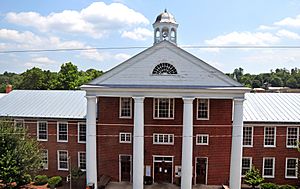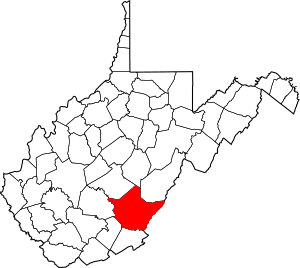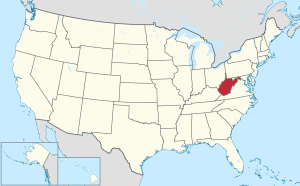Greenbrier County, West Virginia facts for kids
Quick facts for kids
Greenbrier County
|
||
|---|---|---|

Greenbrier County Courthouse in Lewisburg
|
||
|
||

Location within the U.S. state of West Virginia
|
||
 West Virginia's location within the U.S. |
||
| Country | ||
| State | ||
| Founded | October 20, 1778 | |
| Seat | Lewisburg | |
| Largest city | Lewisburg | |
| Area | ||
| • Total | 1,025 sq mi (2,650 km2) | |
| • Land | 1,020 sq mi (2,600 km2) | |
| • Water | 4.9 sq mi (13 km2) 0.5%% | |
| Population
(2020)
|
||
| • Total | 32,977 | |
| • Estimate
(2021)
|
32,608 |
|
| • Density | 32.173/sq mi (12.422/km2) | |
| Time zone | UTC−5 (Eastern) | |
| • Summer (DST) | UTC−4 (EDT) | |
| Congressional district | 1st | |
Greenbrier County (/ˈɡriːnbraɪ.ər/) is a county in the U.S. state of West Virginia. As of the 2020 census, the population was 32,977. Its county seat is Lewisburg. The county was formed in 1778 from Botetourt and Montgomery counties in Virginia.
Contents
History
Prior to the arrival of European settlers around 1740, Greenbrier County, like most of West Virginia, was used as a hunting grounds by the Shawnee and Cherokee Nations. This land, which they called Can-tuc-kee, was thought to be inhabited by ghosts of Azgens, a white people from an eastern sea who were said to have been killed off by the Shawnee's ancestors. According to the legend, the area was owned by the bones and ghosts of the Azgens, who would permit responsible hunting, but according to Black Fish, "we are never allowed to kill the game wantonly, and we are forbidden to settle in the country... If we did, these ghosts would rise from their caves and mounds and slay us, but they would set father against son and son against father and neighbor against neighbor and make them kill one another." Thus, hunting parties were permitted to camp in the area, permanent settlements east and south of the Spay-lay-we-theepi (Ohio River) were forbidden. :65-66
Shawnee leaders, including Pucksinwah and later his son Tecumseh, were alarmed by the arrival of the European settlers, who by 1771 had set up extensive trade in the area, as shown by the day books of early merchants Sampson and George Mathews that record the sale of even luxury items such as silk, hats, silver, and tailor-made suits. Shawnee leaders viewed the white settlements as a violation of the Azgen taboo, and they feared the loss of their hunting lands, which was vital to their survival. Furthermore, they realized it would only be a matter of time before the white settlers crossed the river and occupied their land in present-day Ohio.
By 1774, the Earl of Dunmore, then governor of the colonies of New York and Virginia, decided to raise an army of three thousand to go against the Shawnees in their homeland in present-day Ohio. Half of these men were inducted at Fort Pitt, while the other half assembled at Fort Union, the site of present-day Lewisburg, under the command of General Andrew Lewis. By early October of that year, Lewis' force had marched downstream to the mouth of the Kanawha River, currently the site of Pt. Pleasant, West Virginia, where they fought a famous but indecisive battle against a Shawnee force led by Hokoleskwa, or Cornstalk.:78, 98-99
European settlers were subjected to a number of raids by Native Americans during the colonial period, including a raid on Fort Randolph and later on Fort Donnally, then inhabited by 25 men and 60 women and children. One of the heroic defenders of Fort Donnally was an African American slave named Dick Pointer. Pointer, said to have been nearly 7 feet (2.1 m) tall, defended the log door with Philip Hamman, giving the settlers enough time to awaken and defend themselves. Pointer later addressed the Virginia General Assembly and gave a moving appeal that "in the decline of life" he requested to be freed for his defense of Fort Donnally. Historic accounts differ as to whether the legislature granted his wish. His grave is marked beside Carnegie Hall in the county seat of Lewisburg, and a historical marker stands prominently in the midst of the Lewisburg Cemetery. Pointer’s gun is on permanent display at The Greenbrier Historical Society and John A. North House Museum in Lewisburg.
During the secession crisis of 1861 Greenbrier citizens chose Samuel Price as their delegate to the Richmond convention. On April 17, 1861, the day Virginia's secession ordinance was passed he voted against it, but later changed his mind and signed the official document. When the public vote on the secession ordinance was held on May 23, 1861, Greenbrier county voted 1,000 to 100 in favor of secession. The Civil War came to the county in mid 1861, and several battles were fought in the area, including Lewisburg in May 1862 and White Sulphur Springs in August 1863. Both battles were Union victories. Greenbrier County became part of the new state of West Virginia although it never participated in any of the votes held by the Restored Government in Wheeling. During the war approximately 2,000 men from Greenbrier county joined the Confederate army.
What is claimed to be the oldest golf course in the United States was founded in 1884 just north of White Sulphur Springs by the Montague family.
During the decade prior to World War II, several Civilian Conservation Corps (CCC) camps were located along the Greenbrier River.
For most of the 20th century, the Meadow River Lumber Company operated the world's largest hardwood sawmill in Rainelle.
During World War II The Greenbrier hotel was used as a hospital, and also an internment center for Axis diplomats who were stranded in the United States during the war. When the war ended, it was returned to its former use as a hotel.
Later, during the Cold War, the Greenbrier served as the site of a secret Congressional bunker, built as part of the United States Continuity of Operations Plan.
In the June 2016 floods that affected the state of West Virginia, Greenbrier county suffered 16 casualties, the most of any county. [1]
Geography
According to the U.S. Census Bureau, the county has a total area of 1,025 square miles (2,650 km2), of which 1,020 square miles (2,600 km2) is land and 4.9 square miles (13 km2) (0.5%) is water. It is the second-largest county in West Virginia by area.
Much of the area of the northern and western parts of the county is either public (Monongahela National Forest), coal land, or private forest, owned by companies such as MeadWestvaco and CSX.
In 2005, Invenergy, LLC of Chicago Illinois announced plans to build the $300 million, 124-turbine Beech Ridge Wind Farm along the tops of several Greenbrier County mountains. The wind farm would produce 186 megawatts of electricity. Development, which was originally expected to begin in late 2007, was stalled when the state Supreme Court agreed to hear the case brought by opponents of the project. Ultimately, The Supreme Court ruled in favor of the developers, clearing the way for construction to begin in the summer of 2009. However, in July of that year, a U.S. District Court in Maryland agreed to hear a case filed by opponents.
Adjacent counties
- Webster County (north)
- Pocahontas County (northeast)
- Bath County, Virginia (east)
- Alleghany County, Virginia (southeast)
- Monroe County (south)
- Summers County (southwest)
- Fayette County (west)
- Nicholas County (northwest)
National protected areas
- Lost World Caverns
- Monongahela National Forest (part)
- Organ Cave System
- Greenbrier State Forest
- Washington/Jefferson National Forest (WV/VA Line)
Demographics
| Historical population | |||
|---|---|---|---|
| Census | Pop. | %± | |
| 1790 | 6,015 | — | |
| 1800 | 4,345 | −27.8% | |
| 1810 | 5,914 | 36.1% | |
| 1820 | 7,041 | 19.1% | |
| 1830 | 9,006 | 27.9% | |
| 1840 | 8,695 | −3.5% | |
| 1850 | 10,022 | 15.3% | |
| 1860 | 12,211 | 21.8% | |
| 1870 | 11,417 | −6.5% | |
| 1880 | 15,060 | 31.9% | |
| 1890 | 18,034 | 19.7% | |
| 1900 | 20,683 | 14.7% | |
| 1910 | 24,833 | 20.1% | |
| 1920 | 26,242 | 5.7% | |
| 1930 | 35,878 | 36.7% | |
| 1940 | 38,520 | 7.4% | |
| 1950 | 39,295 | 2.0% | |
| 1960 | 34,446 | −12.3% | |
| 1970 | 32,090 | −6.8% | |
| 1980 | 37,665 | 17.4% | |
| 1990 | 34,693 | −7.9% | |
| 2000 | 34,453 | −0.7% | |
| 2010 | 35,480 | 3.0% | |
| 2020 | 32,977 | −7.1% | |
| 2021 (est.) | 32,608 | −8.1% | |
| U.S. Decennial Census 1790–1960 1900–1990 1990–2000 2010–2020 |
|||
2010 census
As of the 2010 United States Census, there were 35,480 people, 15,443 households, and 9,903 families residing in the county. The population density was 34.8 inhabitants per square mile (13.4/km2). There were 18,980 housing units at an average density of 18.6 per square mile (7.2/km2). The racial makeup of the county was 94.6% white, 2.8% black or African American, 0.4% Asian, 0.3% American Indian, 0.4% from other races, and 1.5% from two or more races. Those of Hispanic or Latino origin made up 1.2% of the population. In terms of ancestry, 17.8% were Irish, 17.0% were German, 12.0% were English, and 10.0% were American.
Of the 15,443 households, 26.1% had children under the age of 18 living with them, 48.9% were married couples living together, 10.8% had a female householder with no husband present, 35.9% were non-families, and 30.6% of all households were made up of individuals. The average household size was 2.26 and the average family size was 2.79. The median age was 45.0 years.
The median income for a household in the county was $33,732 and the median income for a family was $43,182. Males had a median income of $34,845 versus $27,254 for females. The per capita income for the county was $20,044. About 14.7% of families and 19.4% of the population were below the poverty line, including 23.5% of those under age 18 and 13.6% of those age 65 or over.
Education
Public schools
Greenbrier County Schools is the operating school system within Greenbrier County. The school system is governed by the Greenbrier County Board of Education, which is elected on a non-partisan basis. The Superintendent of Schools, who is appointed by the Board, provides administrative supervision for the system. The School Board Office is located on Church Street in Lewisburg. Following a trend in West Virginia, schools at the secondary level are consolidated, while elementary schools continue to be located within small communities.
- Alderson Elementary School
- Crichton Elementary School
- Eastern Greenbrier Middle School
- Frankford Elementary School
- Greenbrier East High School
- Greenbrier West High School
- Lewisburg Elementary School
- Rainelle Elementary School
- Ronceverte Elementary School
- Rupert Elementary School
- Smoot Elementary School
- Western Greenbrier Middle School
- White Sulphur Springs Elementary School
Private Schools
- Greenbrier Community School (Formerly Greenbrier Episcopal School)
- Seneca Trail Academy
- Renick Christian School
- Lewisburg Baptist Academy
Former Schools (Incomplete)
- Alderson High/Jr. High School
- Alvon/Neola School (Near White Sulphur Springs)
- Baldwin School
- Boling School
- Brushy Flat School
- Charmco School
- Chestnut Ridge School
- Crichton High/Jr. High
- Crawley School
- East Rainelle School
- Frankford High/Jr. High School
- Friars Hill School
- Greenbrier Church/School (Bingham Mountain)
- Greenbrier High/Jr.High School (Ronceverte)
- Greenbrier School of Practical Nursing (campus of Greenbrier East High School)
- Lewisburg Intermediate School
- Lewisburg Elem./Jr. High School (Lewisburg High/Jr./Elem.)
- May School
- Mill Spring School
- Mt. Vernon School
- New Piedmont School
- Rainelle Christian Academy (RCA)
- Rainelle High/Jr. High School
- Renick High/Jr. High School
- Renick Elementary School
- Rockcamp School
- Rupert High/Jr. High School
- Smoot High/Jr. High School
- Snowflake School
- Sugar Grove School
- Vires School
- White Sulphur Springs High/Jr. High School
- Whiteoak Grove School
- Williamsburg High/Jr. High School
- Williamsburg Elementary School
Other
- Alternative/Home Schooling (County-wide)
- West Virginia State Virtual School
Colleges and universities
- New River Community and Technical College (NRCTC), Greenbrier Valley Campus
- West Virginia School of Osteopathic Medicine (WVSOM)
Transportation
Airports
Greenbrier Valley Airport is a single runway airport 3 miles north of Lewisburg, West Virginia. Flights are provided by Contour Airlines.
Railroads
Amtrak, the national passenger rail service, provides service to White Sulphur Springs and Alderson under the Cardinal route.
Major highways
 Interstate 64
Interstate 64 U.S. Route 60
U.S. Route 60 U.S. Route 219
U.S. Route 219 West Virginia Route 12
West Virginia Route 12 West Virginia Route 20
West Virginia Route 20 West Virginia Route 39
West Virginia Route 39 West Virginia Route 55
West Virginia Route 55 West Virginia Route 63
West Virginia Route 63 West Virginia Route 92
West Virginia Route 92
Communities
Cities
- Lewisburg (county seat)
- Ronceverte
- White Sulphur Springs
Towns
Census-designated place
See also
 In Spanish: Condado de Greenbrier para niños
In Spanish: Condado de Greenbrier para niños


